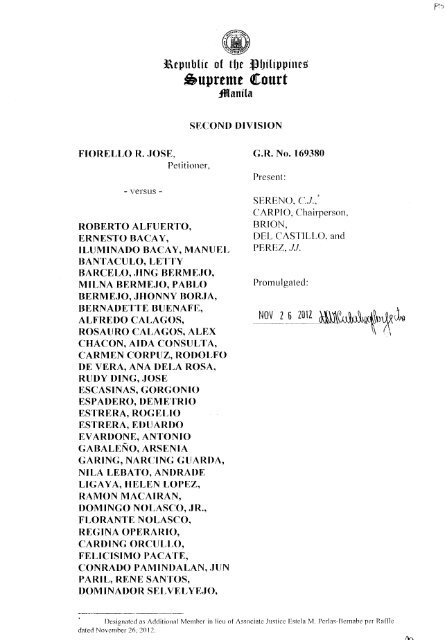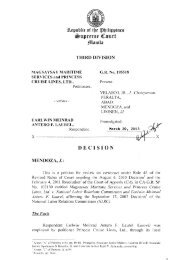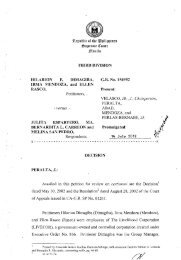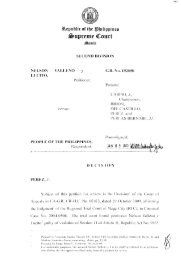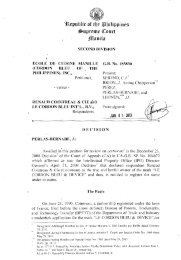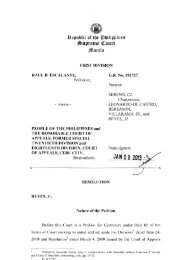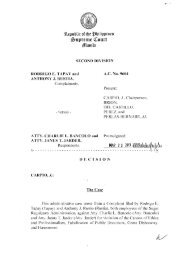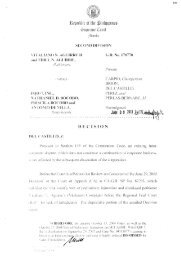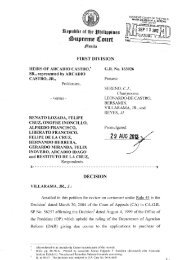G.R. No. 169380. November 26, 2012 - Supreme Court of the ...
G.R. No. 169380. November 26, 2012 - Supreme Court of the ...
G.R. No. 169380. November 26, 2012 - Supreme Court of the ...
Create successful ePaper yourself
Turn your PDF publications into a flip-book with our unique Google optimized e-Paper software.
p··,l\epublir <strong>of</strong> tf)e lliJillppines~uprtntt (!<strong>Court</strong>:manilaSF,COND DIVISIONFIORELLO R. JOSE,Petitioner,-versus-ROBERTO ALFtJERTO,ERNEST() BACA Y,ILUMINADO BACAY, MANUELBANTACULO,LETTYBARCELO, .JING BERME.JO,MILNA BERME.JO, PABLOBERMEJO, .JHONNY BOR.JA,BERNADETTE BUENAFI~,ALFREDO CALAGOS,ROSAURO CALAGOS, ALEXCHACON, AIDA CONSUL TA,CARMEN CORPUZ, RO()OLFODE VERA, ANA DELAROSA,RUDY DING, .JOSEESCASINAS, GORGONIOESPADERO, DEMETRIOESTRERA, ROGELIOESTRERA, EDUARDOEV ARDONE, ANTONIOGABALE~O,ARSENIAGARING, NARCING GUARDA,NILA LEBA TO, ANDRADELIGA Y A, HELEN LOPEZ,RAMON MACAIRAN,DOMINGO NOLASCO, JR.,FLORANTE NOLASCO,REGINA OPERARIO,CARDING ORCULLO,FELICISIMO PACATE,CONRADO P AMINDALAN, .JlJNPARIL, RENE SANTOS,DOMINADOR SELVELYE.JO,G.R. <strong>No</strong>. 169380Present:SERENO, C.J.,*CARPIO, Chairperson,BRION,DEL CASTILLO, andPEREZ, JJ.Promulgated:Designated as Aclditiorwl Member in lieu <strong>of</strong> Associate Justice Estela M. Perlas-Bernabe per Raffledated <strong>No</strong>vember <strong>26</strong>. <strong>2012</strong>.
Decision 2G.R. <strong>No</strong>. 169380VILLAR, JOHN DOE, JANEDOE and Unknown Occupants <strong>of</strong>Olivares Compound, Phase II,Barangay San Dionisio,Parañaque City,Respondents.x-----------------------------------------------------------------------------------------xBRION, J.:D E C I S I O NBefore us is a petition for review on certiorari under Rule 45 <strong>of</strong> <strong>the</strong>Rules <strong>of</strong> <strong>Court</strong> assailing <strong>the</strong> decision 1 dated March 14, 2005 <strong>of</strong> <strong>the</strong> <strong>Court</strong> <strong>of</strong>Appeals in CA-G.R. SP <strong>No</strong>. 80166. The <strong>Court</strong> <strong>of</strong> Appeals’ decision reversed<strong>the</strong> decisions <strong>of</strong> <strong>the</strong> Regional Trial <strong>Court</strong> (RTC) <strong>of</strong> Parañaque City, Branch257, and <strong>of</strong> <strong>the</strong> Metropolitan Trial <strong>Court</strong> (MeTC) <strong>of</strong> Parañaque City, Branch77, by dismissing petitioner Fiorello R. Jose’s complaint for ejectmentagainst Roberto Alfuerto, Ernesto Bacay, Iluminado Bacay, ManuelBantaculo, Letty Barcelo, Jing Bermejo, Milna Bermejo, Pablo Bermejo,Jhonny Borja, Bernadette Buenafe, Alfredo Calagos, Rosauro Calagos, AlexChacon, Aida Consulta, Carmen Corpuz, Rodolfo De Vera, Ana Dela Rosa,Rudy Ding, Jose Escasinas, Gorgonio Espadero, Demetrio Estrera, RogelioEstrera, Eduardo Evardone, Antonio Gabaleño, Arsenia Garing, NarcingGuarda, Nila Lebato, Andrade Ligaya, Helen Lopez, Ramon Macairan,Domingo <strong>No</strong>lasco, Jr., Florante <strong>No</strong>lasco, Regina Operario, Carding Orcullo,Felicisimo Pacate, Conrado Pamindalan, Jun Paril, Rene Santos, DominadorSelvelyejo, Rosario Ubaldo, Sergio Villar, John Doe, Jane Doe andUnknown Occupants <strong>of</strong> Olivares Compound, Phase II, Barangay SanDionisio, Parañaque City (respondents), on <strong>the</strong> ground that <strong>the</strong> petitioner’scause <strong>of</strong> action was not for unlawful detainer but for recovery <strong>of</strong> possession.The appellate court affirmed this decision in its resolution <strong>of</strong> August 22,2005. 21Rollo, pp. 21-34; penned by Associate Justice Hakim S. Abdulwahid, and concurred in byAssociate Justices Elvi John S. Asuncion and Estela M. Perlas-Bernabe (now Associate Justice <strong>of</strong> <strong>the</strong><strong>Supreme</strong> <strong>Court</strong>).2Id. at 36-37.
Decision 3G.R. <strong>No</strong>. 169380The dispute involves a parcel <strong>of</strong> land registered in <strong>the</strong> name <strong>of</strong>Rodolfo Chua Sing under Transfer Certificate <strong>of</strong> Title <strong>No</strong>. 52594, 3 with anarea <strong>of</strong> 1919 square meters, located in Barangay San Dionisio, ParañaqueCity. Chua Sing purchased <strong>the</strong> land in 1991. On April 1, 1999, Chua Singleased <strong>the</strong> property to <strong>the</strong> petitioner. Their contract <strong>of</strong> lease was nei<strong>the</strong>rnotarized nor registered with <strong>the</strong> Parañaque City Registry <strong>of</strong> Deeds. 4The lease contract provided that:That <strong>the</strong> term <strong>of</strong> this lease shall be FIVE (5) years and renewablefor <strong>the</strong> same period upon mutual agreement <strong>of</strong> <strong>the</strong> parties to commenceupon <strong>the</strong> total eviction <strong>of</strong> any occupant or occupants. The LESSORhereby transfers all its rights and prerogative to evict said occupants infavor <strong>of</strong> <strong>the</strong> LESSEE which shall be responsible for all expenses that maybe incurred without reimbursement from <strong>the</strong> LESSOR. It is understoodhowever that <strong>the</strong> LESSOR is hereby waiving, in favor <strong>of</strong> <strong>the</strong> LESSEE anyand all damages that [may be] recovered from <strong>the</strong> occupants[.] 5(Underscore ours)Significantly, <strong>the</strong> respondents already occupied <strong>the</strong> property evenbefore <strong>the</strong> lease contract was executed.On April 28, 1999, soon after Chua Sing and <strong>the</strong> petitioner signed <strong>the</strong>lease contract, <strong>the</strong> petitioner demanded in writing that <strong>the</strong> respondents vacate<strong>the</strong> property within 30 days and that <strong>the</strong>y pay a monthly rental <strong>of</strong> P1,000.00until <strong>the</strong>y fully vacate <strong>the</strong> property. 6The respondents refused to vacate and to pay rent. On October 20,1999, <strong>the</strong> petitioner filed an ejectment case against <strong>the</strong> respondents beforeBranch 77 <strong>of</strong> <strong>the</strong> Parañaque City MeTC, docketed as Civil Case <strong>No</strong>. 11344. 7In this complaint, no mention was made <strong>of</strong> any proceedings before <strong>the</strong>barangay. Jose <strong>the</strong>n brought <strong>the</strong> dispute before <strong>the</strong> barangay for34567Id. at 180-181.Id. at 178-179.Id. at 56.Id. at 182-228.Id. at 163.
Decision 4G.R. <strong>No</strong>. 169380conciliation. 8 The barangay issued a Certification to File Action on March1, 2000. 9 Jose was <strong>the</strong>n able to file an amended complaint, incorporating <strong>the</strong>proceedings before <strong>the</strong> barangay before <strong>the</strong> summons and copies <strong>of</strong> <strong>the</strong>complaint were served upon <strong>the</strong> named defendants. 10In <strong>the</strong> Amended Complaint 11 dated March 17, 2000, <strong>the</strong> petitionerclaimed that as lessee <strong>of</strong> <strong>the</strong> subject property, he had <strong>the</strong> right to eject <strong>the</strong>respondents who unlawfully occupy <strong>the</strong> land. He alleged that:7. Defendants, having been fully aware <strong>of</strong> <strong>the</strong>ir unlawful occupancy <strong>of</strong> <strong>the</strong>subject lot, have defiantly erected <strong>the</strong>ir houses <strong>the</strong>reat without benefit <strong>of</strong>any contract or law whatsoever, much less any building permit assanctioned by law, but by mere tolerance <strong>of</strong> its true, lawful and registeredowner, plaintiff’s lessor. 12The petitioner also stated that despite his written demand, <strong>the</strong> respondentsfailed to vacate <strong>the</strong> property without legal justification. He prayed that <strong>the</strong>court order <strong>the</strong> respondents; (1) to vacate <strong>the</strong> premises; (2) to pay him notless than P41,000.00 a month from May 30,1999 until <strong>the</strong>y vacate <strong>the</strong>premises; and (3) to pay him attorney’s fees <strong>of</strong> no less than P50,000.00, and<strong>the</strong> costs <strong>of</strong> suit. 13In <strong>the</strong>ir Answer, <strong>the</strong> respondents likewise pointed out that <strong>the</strong>y havebeen in possession <strong>of</strong> <strong>the</strong> land long before Chua Sing acquired <strong>the</strong> propertyin 1991, and that <strong>the</strong> lease contract between <strong>the</strong> petitioner and Chua Singdoes not affect <strong>the</strong>ir right to possess <strong>the</strong> land. The respondents alsopresented a Deed <strong>of</strong> Assignment, 14 dated February 13, 2000, issued byDavid R. Dulfo in <strong>the</strong>ir favor. They argued that <strong>the</strong> MeTC had no8CA rollo, pp. 162-184, 209. The records do not state when <strong>the</strong> conciliation meeting occurred.Never<strong>the</strong>less, <strong>the</strong> respondents did not dispute that <strong>the</strong> conciliation meeting took place during <strong>the</strong> MeTCproceedings, nor appear to have raised this as a ground for dismissal in <strong>the</strong>ir Amended Answer. However,in <strong>the</strong>ir Memorandum before <strong>the</strong> <strong>Court</strong> <strong>of</strong> Appeals, <strong>the</strong>y stated that a conciliation meeting between <strong>the</strong>proper parties did not take place; it is unclear whe<strong>the</strong>r <strong>the</strong>y were saying that no meeting between Chua Singand <strong>the</strong> respondents took place or that no conciliation meeting between <strong>the</strong> petitioner and <strong>the</strong> respondentsoccurred. The CA did not resolve this issue, and no petition was filed before <strong>the</strong> <strong>Supreme</strong> <strong>Court</strong> by ei<strong>the</strong>rparty raising this issue, even if <strong>the</strong> respondents again raise it in <strong>the</strong>ir Memorandum before <strong>the</strong> <strong>Court</strong>.9CA rollo, pp. 162-184.10Motion to Admit Amended Complaint dated March 22, 2000. Records, volume I, p. 93.11Rollo, pp. 227-230.12Id. at 175.13Id. at 176.14Id. at 232-239.
Decision 5G.R. <strong>No</strong>. 169380jurisdiction over <strong>the</strong> case as <strong>the</strong> issue deals with ownership <strong>of</strong> <strong>the</strong> land, andsought <strong>the</strong> dismissal <strong>of</strong> <strong>the</strong> complaint for lack <strong>of</strong> cause <strong>of</strong> action and for lack<strong>of</strong> jurisdiction. They also filed a counterclaim for actual and moral damagesfor <strong>the</strong> filing <strong>of</strong> a baseless and malicious suit.After <strong>the</strong> required position papers, affidavits and o<strong>the</strong>r pieces <strong>of</strong>evidence were submitted, <strong>the</strong> MeTC resolved <strong>the</strong> case in <strong>the</strong> petitioner’sfavor. In its decision 15 <strong>of</strong> January 27, 2003, <strong>the</strong> MeTC held that <strong>the</strong>respondents had no right to possess <strong>the</strong> land and that <strong>the</strong>ir occupation wasmerely by <strong>the</strong> owner’s tolerance. It fur<strong>the</strong>r noted that <strong>the</strong> respondents couldno longer raise <strong>the</strong> issue <strong>of</strong> ownership, as this issue had already been settled:<strong>the</strong> respondents previously filed a case for <strong>the</strong> annulment/cancellation <strong>of</strong>Chua Sing’s title before <strong>the</strong> RTC, Branch <strong>26</strong>0, <strong>of</strong> Parañaque City, whichruled that <strong>the</strong> registered owner’s title was genuine and valid. Moreover, <strong>the</strong>MeTC held that it is not divested <strong>of</strong> jurisdiction over <strong>the</strong> case because <strong>of</strong> <strong>the</strong>respondents’ assertion <strong>of</strong> ownership <strong>of</strong> <strong>the</strong> property. On <strong>the</strong>se premises, <strong>the</strong>MeTC ordered <strong>the</strong> respondents to vacate <strong>the</strong> premises and to remove allstructures introduced on <strong>the</strong> land; to each pay P500.00 per month from <strong>the</strong>date <strong>of</strong> filing <strong>of</strong> this case until <strong>the</strong>y vacate <strong>the</strong> premises; and to pay Jose,jointly and severally, <strong>the</strong> costs <strong>of</strong> suit and P20,000.00 as attorney’s fees.On appeal before <strong>the</strong> RTC, <strong>the</strong> respondents raised <strong>the</strong> issue, amongo<strong>the</strong>rs, that no legal basis exists for <strong>the</strong> petitioner’s claim that <strong>the</strong>iroccupation was by tolerance, “where <strong>the</strong> possession <strong>of</strong> <strong>the</strong> defendants wasillegal at <strong>the</strong> inception as alleged in <strong>the</strong> complaint[,] <strong>the</strong>re can be notolerance.” 16The RTC affirmed <strong>the</strong> MeTC decision <strong>of</strong> January 27, 2003. It issuedits decision 17 on October 8, 2003, reiterating <strong>the</strong> MeTC’s ruling that a casefor ejectment was proper. The petitioner, as lessee, had <strong>the</strong> right to file <strong>the</strong>ejectment complaint; <strong>the</strong> respondents occupied <strong>the</strong> land by mere tolerance151617Id. at 137-141.Id. at 44.Id. at 1<strong>26</strong>-136.
Decision 6G.R. <strong>No</strong>. 169380and <strong>the</strong>ir possession became unlawful upon <strong>the</strong> petitioner’s demand tovacate on April 28, 1999. The RTC, moreover, noted that <strong>the</strong> complaint forejectment was filed on October 20, 1999, or within one year after <strong>the</strong>unlawful deprivation took place. It cited Pangilinan, et al. v. Hon. Aguilar,etc., et al. 18 and Yu v. Lara, et al. 19 to support its ruling that a case forunlawful detainer was appropriate.On March 14, 2005, <strong>the</strong> <strong>Court</strong> <strong>of</strong> Appeals reversed <strong>the</strong> RTC andMeTC decisions. 20 It ruled that <strong>the</strong> respondents’ possession <strong>of</strong> <strong>the</strong> land wasnot by <strong>the</strong> petitioner or his lessor’s tolerance. It defined tolerance not merelyas <strong>the</strong> silence or inaction <strong>of</strong> a lawful possessor when ano<strong>the</strong>r occupies hisland; tolerance entailed permission from <strong>the</strong> owner by reason <strong>of</strong> familiarityor neighborliness. The petitioner, however, alleged that <strong>the</strong> respondentsunlawfully entered <strong>the</strong> property; thus, tolerance (or authorized entry into <strong>the</strong>property) was not alleged and <strong>the</strong>re could be no case for unlawful detainer.The respondents’ allegation that <strong>the</strong>y had been in possession <strong>of</strong> <strong>the</strong> landbefore <strong>the</strong> petitioner’s lessor had acquired it in 1991 supports this finding.Having been in possession <strong>of</strong> <strong>the</strong> land for more than a year, <strong>the</strong> respondentsshould not be evicted through an ejectment case.The <strong>Court</strong> <strong>of</strong> Appeals emphasized that ejectment cases are summaryproceedings where <strong>the</strong> only issue to be resolved is who has a better right to<strong>the</strong> physical possession <strong>of</strong> a property. The petitioner’s claim, on <strong>the</strong> o<strong>the</strong>rhand, is based on an accion publiciana: he asserts his right as a possessor byvirtue <strong>of</strong> a contract <strong>of</strong> lease he contracted after <strong>the</strong> respondents had occupied<strong>the</strong> land. The dispositive part <strong>of</strong> <strong>the</strong> decision reads:WHEREFORE, <strong>the</strong> instant petition is GRANTED. The decisiondated October 8, 2003 <strong>of</strong> <strong>the</strong> RTC, Branch 257, Parañaque City, in CivilCase <strong>No</strong>. 03-0127, is REVERSED and SET ASIDE and <strong>the</strong> amendedcomplaint for ejectment is DISMISSED. 2118192021150 Phil. 166 (1972).116 Phil. 1105 (1962).Supra note 1.Id. at 33.
Decision 7G.R. <strong>No</strong>. 169380The petitioner filed a motion for reconsideration, 22 which <strong>the</strong> <strong>Court</strong> <strong>of</strong>Appeals denied in its resolution 23 <strong>of</strong> August 22, 2005. In <strong>the</strong> present appeal,<strong>the</strong> petitioner raises before us <strong>the</strong> following issues:IWHETHER OR NOT THE COURT OF APPEALS ERRED INHOLDING THAT THE CAUSE OF ACTION OF THE SUBJECTCOMPLAINT IS NOT FOR UNLAWFUL DETAINER BUT FORRECOVERY OF POSSESSION AND THEREFORE DISMISSIBLEIIWHETHER OR NOT THE COURT OF APPEALS ERRED INDECIDING THE CASE BASED ON RESPONDENTS’ MATERIALCHANGE OF THEORY WHICH IS COMPLETELY INCONSISTENTWITH THEIR DEFENSES INVOKED BEFORE THE MUNICIPALTRIAL COURTIIIWHETHER OR NOT THIS HONORABLE COURT MAY DECIDE THISCASE ON THE MERITS TO AVOID CIRCUITOUS PROCEDURE INTHE ADMINISTRATION OF JUSTICE. 24The <strong>Court</strong>’s RulingWe find <strong>the</strong> petition unmeritorious.Unlawful detainer is not <strong>the</strong> properremedy for <strong>the</strong> present case.The key issue in this case is whe<strong>the</strong>r an action for unlawful detainer is<strong>the</strong> proper remedy.Unlawful detainer is a summary action for <strong>the</strong> recovery <strong>of</strong> possession<strong>of</strong> real property. This action may be filed by a lessor, vendor, vendee, oro<strong>the</strong>r person against whom <strong>the</strong> possession <strong>of</strong> any land or building isunlawfully withheld after <strong>the</strong> expiration or termination <strong>of</strong> <strong>the</strong> right to hold222324CA rollo, pp. 258-<strong>26</strong>4.Rollo, pp. 36-37.Id. at 7.
Decision 8G.R. <strong>No</strong>. 169380possession by virtue <strong>of</strong> any contract, express or implied. In unlawfuldetainer, <strong>the</strong> possession <strong>of</strong> <strong>the</strong> defendant was originally legal, as hispossession was permitted by <strong>the</strong> plaintiff on account <strong>of</strong> an express orimplied contract between <strong>the</strong>m. However, <strong>the</strong> defendant’s possessionbecame illegal when <strong>the</strong> plaintiff demanded that <strong>the</strong> defendant vacate <strong>the</strong>subject property due to <strong>the</strong> expiration or termination <strong>of</strong> <strong>the</strong> right to possessunder <strong>the</strong> contract, and <strong>the</strong> defendant refused to heed such demand. A casefor unlawful detainer must be instituted one year from <strong>the</strong> unlawfulwithholding <strong>of</strong> possession. 25The allegations in <strong>the</strong> complaint determine both <strong>the</strong> nature <strong>of</strong> <strong>the</strong>action and <strong>the</strong> jurisdiction <strong>of</strong> <strong>the</strong> court. The complaint must specificallyallege <strong>the</strong> facts constituting unlawful detainer. In <strong>the</strong> absence <strong>of</strong> <strong>the</strong>seallegations <strong>of</strong> facts, an action for unlawful detainer is not <strong>the</strong> proper remedyand <strong>the</strong> municipal trial court or <strong>the</strong> MeTC does not have jurisdiction over <strong>the</strong>case. <strong>26</strong> In his amended complaint, <strong>the</strong> petitioner presents <strong>the</strong> followingallegations in support <strong>of</strong> his unlawful detainer complaint:3. On April 1, 1999, plaintiff leased from lessor, Mr. Rudy Chuasing, thatparcel <strong>of</strong> lot owned and registered in [<strong>the</strong>] lessor’s name, covering <strong>the</strong>area occupied by <strong>the</strong> defendants.xxxx6. Plaintiff’s lessor had acquired <strong>the</strong> subject property as early as 1991through sale, <strong>the</strong>reafter <strong>the</strong> aforesaid Transfer Certificate <strong>of</strong> Title wassubsequently registered under his name.7. Defendants, having been fully aware <strong>of</strong> <strong>the</strong>ir unlawful occupancy <strong>of</strong><strong>the</strong> subject lot, have defiantly erected <strong>the</strong>ir houses <strong>the</strong>reat withoutbenefit <strong>of</strong> any contract or law whatsoever, much less any buildingpermit as sanctioned by law, but by mere tolerance <strong>of</strong> its true, lawfuland registered owner, plaintiff’s lessor.8. By reason <strong>of</strong> defendants’ continued unlawful occupancy <strong>of</strong> <strong>the</strong> subjectpremises, plaintiff referred <strong>the</strong> matter to his lawyer who immediatelysent a formal demand upon each <strong>of</strong> <strong>the</strong> defendants to vacate <strong>the</strong>25<strong>26</strong>Estate <strong>of</strong> Soledad Manantan v. Somera, G.R. <strong>No</strong>. 145867, April 7, 2009, 584 SCRA 81, 89-90.Id. at 90; Canlas v. Tubil, G.R. <strong>No</strong>. 184285, September 25, 2009, 601 SCRA 147, 156.
Decision 9G.R. <strong>No</strong>. 169380premises. Copies <strong>of</strong> <strong>the</strong> demand letter dated 28 April 1999 are xxxhereto attached as annexes “C” to “QQ[.]”9. Despite notice, however, defendants failed and refused and continues t<strong>of</strong>ail and refuse to vacate <strong>the</strong> premises without valid or legaljustification. 27 (emphasis ours)The petitioner’s allegations in <strong>the</strong> amended complaint run counter to<strong>the</strong> requirements for unlawful detainer. In an unlawful detainer action, <strong>the</strong>possession <strong>of</strong> <strong>the</strong> defendant was originally legal and his possession waspermitted by <strong>the</strong> owner through an express or implied contract.In this case, paragraph 7 makes it clear that <strong>the</strong> respondents’occupancy was unlawful from <strong>the</strong> start and was bereft <strong>of</strong> contractual or legalbasis. In an unlawful detainer case, <strong>the</strong> defendant’s possession becomesillegal only upon <strong>the</strong> plaintiff’s demand for <strong>the</strong> defendant to vacate <strong>the</strong>property and <strong>the</strong> defendant’s subsequent refusal. In <strong>the</strong> present case,paragraph 8 characterizes <strong>the</strong> defendant’s occupancy as unlawful evenbefore <strong>the</strong> formal demand letters were written by <strong>the</strong> petitioner’s counsel.Under <strong>the</strong>se allegations, <strong>the</strong> unlawful withholding <strong>of</strong> possession should notbe based on <strong>the</strong> date <strong>the</strong> demand letters were sent, as <strong>the</strong> alleged unlawfulact had taken place at an earlier unspecified date.The petitioner never<strong>the</strong>less insists that he properly alleged that <strong>the</strong>respondents occupied <strong>the</strong> premises by mere tolerance <strong>of</strong> <strong>the</strong> owner. <strong>No</strong>allegation in <strong>the</strong> complaint nor any supporting evidence on record, however,shows when <strong>the</strong> respondents entered <strong>the</strong> property or who had granted <strong>the</strong>mpermission to enter. Without <strong>the</strong>se allegations and evidence, <strong>the</strong> bare claimregarding “tolerance” cannot be upheld.In Sarona, et al. v. Villegas, et al., 28 <strong>the</strong> <strong>Court</strong> cited Pr<strong>of</strong>. Arturo M.Tolentino’s definition and characterizes “tolerance” in <strong>the</strong> followingmanner:2728Rollo, pp. 80-81.131 Phil. 365, 372 (1968).
Decision 10G.R. <strong>No</strong>. 169380Pr<strong>of</strong>essor Arturo M. Tolentino states that acts merely tolerated are “thosewhich by reason <strong>of</strong> neighborliness or familiarity, <strong>the</strong> owner <strong>of</strong> propertyallows his neighbor or ano<strong>the</strong>r person to do on <strong>the</strong> property; <strong>the</strong>y aregenerally those particular services or benefits which one’s property cangive to ano<strong>the</strong>r without material injury or prejudice to <strong>the</strong> owner, whopermits <strong>the</strong>m out <strong>of</strong> friendship or courtesy.” He adds that: “[t]hey are acts<strong>of</strong> little disturbances which a person, in <strong>the</strong> interest <strong>of</strong> neighborliness orfriendly relations, permits o<strong>the</strong>rs to do on his property, such as passing over<strong>the</strong> land, tying a horse <strong>the</strong>rein, or getting some water from a well.” And,Tolentino continues, even though “this is continued for a long time, noright will be acquired by prescription.” Fur<strong>the</strong>r expounding on <strong>the</strong> concept,Tolentino writes: “There is tacit consent <strong>of</strong> <strong>the</strong> possessor to <strong>the</strong> acts whichare merely tolerated. Thus, not every case <strong>of</strong> knowledge and silence on <strong>the</strong>part <strong>of</strong> <strong>the</strong> possessor can be considered mere tolerance. By virtue <strong>of</strong>tolerance that is considered as an authorization, permission or license, acts<strong>of</strong> possession are realized or performed. The question reduces itself to <strong>the</strong>existence or non-existence <strong>of</strong> <strong>the</strong> permission. [citations omitted; italicssupplied]The <strong>Court</strong> has consistently adopted this position: tolerance orpermission must have been present at <strong>the</strong> beginning <strong>of</strong> possession; if <strong>the</strong>possession was unlawful from <strong>the</strong> start, an action for unlawful detainerwould not be <strong>the</strong> proper remedy and should be dismissed. 29It is not <strong>the</strong> first time that this <strong>Court</strong> adjudged contradictorystatements in a complaint for unlawful detainer as a basis for dismissal. InUnida v. Heirs <strong>of</strong> Urban, 30 <strong>the</strong> claim that <strong>the</strong> defendant’s possession wasmerely tolerated was contradicted by <strong>the</strong> complainant’s allegation that <strong>the</strong>entry to <strong>the</strong> subject property was unlawful from <strong>the</strong> very beginning. The<strong>Court</strong> <strong>the</strong>n ruled that <strong>the</strong> unlawful detainer action should fail.The contradictory statements in <strong>the</strong> complaint are fur<strong>the</strong>r deemedsuspicious when a complaint is silent regarding <strong>the</strong> factual circumstancessurrounding <strong>the</strong> alleged tolerance. In Ten Forty Realty Corporation v.Cruz, 31<strong>the</strong> complaint simply stated that: “(1) [defendant] immediatelyoccupied <strong>the</strong> subject property after its sale to her, an action merely toleratedby [<strong>the</strong> plaintiff]; and (2) [<strong>the</strong> respondent’s] allegedly illegal occupation <strong>of</strong><strong>the</strong> premises was by mere tolerance.” The <strong>Court</strong> expressed its qualms over29Ten Forty Realty and Development Corporation v. Cruz, 457 Phil. 603, 610 (2003); and Go, Jr. v.<strong>Court</strong> <strong>of</strong> Appeals, 415 Phil. 172, 185 (2001).30499 Phil. 64, 70 (2005).31Supra note 29, at 611.
Decision 11G.R. <strong>No</strong>. 169380<strong>the</strong>se averments <strong>of</strong> fact as <strong>the</strong>y did not contain anything substantiating <strong>the</strong>claim that <strong>the</strong> plaintiff tolerated or permitted <strong>the</strong> occupation <strong>of</strong> <strong>the</strong> propertyby <strong>the</strong> defendant:These allegations contradict, ra<strong>the</strong>r than support, [plaintiff’s] <strong>the</strong>orythat its cause <strong>of</strong> action is for unlawful detainer. First, <strong>the</strong>se argumentsadvance <strong>the</strong> view that [defendant’s] occupation <strong>of</strong> <strong>the</strong> property wasunlawful at its inception. Second, <strong>the</strong>y counter <strong>the</strong> essential requirement inunlawful detainer cases that [plaintiff’s] supposed act <strong>of</strong> sufferance ortolerance must be present right from <strong>the</strong> start <strong>of</strong> a possession that is latersought to be recovered.As <strong>the</strong> bare allegation <strong>of</strong> [plaintiff’s] tolerance <strong>of</strong> [defendant’s]occupation <strong>of</strong> <strong>the</strong> premises has not been proven, <strong>the</strong> possession should bedeemed illegal from <strong>the</strong> beginning. Thus, <strong>the</strong> CA correctly ruled that <strong>the</strong>ejectment case should have been for forcible entry — an action that hadalready prescribed, however, when <strong>the</strong> Complaint was filed on May 12,1999. The prescriptive period <strong>of</strong> one year for forcible entry cases isreckoned from <strong>the</strong> date <strong>of</strong> [defendant’s] actual entry into <strong>the</strong> land, which inthis case was on April 24, 1998. 32Similarly, in Go, Jr. v. <strong>Court</strong> <strong>of</strong> Appeals, 33 <strong>the</strong> <strong>Court</strong> considered <strong>the</strong> owner’slack <strong>of</strong> knowledge <strong>of</strong> <strong>the</strong> defendant’s entry <strong>of</strong> <strong>the</strong> land to be inconsistentwith <strong>the</strong> allegation that <strong>the</strong>re had been tolerance.In Padre v. Malabanan, 34 <strong>the</strong> <strong>Court</strong> not only required allegationsregarding <strong>the</strong> grant <strong>of</strong> permission, but pro<strong>of</strong> as well. It noted that <strong>the</strong>plaintiffs alleged <strong>the</strong> existence <strong>of</strong> tolerance, but ordered <strong>the</strong> dismissal <strong>of</strong> <strong>the</strong>unlawful detainer case because <strong>the</strong> evidence was “totally wanting as to whenand under what circumstances xxx <strong>the</strong> alleged tolerance came about.” Itstated that:Judging from <strong>the</strong> respondent’s Answer, <strong>the</strong> petitioners were never at all inphysical possession <strong>of</strong> <strong>the</strong> premises from <strong>the</strong> time he started occupying itand continuously up to <strong>the</strong> present. For sure, <strong>the</strong> petitioners merely derived<strong>the</strong>ir alleged prior physical possession only on <strong>the</strong> basis <strong>of</strong> <strong>the</strong>ir TransferCertificate <strong>of</strong> Title (TCT), arguing that <strong>the</strong> issuance <strong>of</strong> said titlepresupposes <strong>the</strong>ir having been in possession <strong>of</strong> <strong>the</strong> property at one time orano<strong>the</strong>r. 3532333435Ibid.Supra note 29, at 186.532 Phil. 714, 721 (2006).Ibid.
Decision 12G.R. <strong>No</strong>. 169380Thus, <strong>the</strong> complainants in unlawful detainer cases cannot simply anchor<strong>the</strong>ir claims on <strong>the</strong> validity <strong>of</strong> <strong>the</strong> owner’s title. Possession de facto mustalso be proved.As early as <strong>the</strong> 1960s, in Sarona, et al. v. Villegas, et al., 36 we alreadyruled that a complaint which fails to positively aver any overt act on <strong>the</strong>plaintiff’s part indicative <strong>of</strong> permission to occupy <strong>the</strong> land, or any showing<strong>of</strong> such fact during <strong>the</strong> trial is fatal for a case for unlawful detainer. As <strong>the</strong><strong>Court</strong> <strong>the</strong>n explained, a case for unlawful detainer alleging tolerancemust definitely establish its existence from <strong>the</strong> start <strong>of</strong> possession;o<strong>the</strong>rwise, a case for forcible entry can mask itself as an action forunlawful detainer and permit it to be filed beyond <strong>the</strong> required one-yearprescription period from <strong>the</strong> time <strong>of</strong> forcible entry:A close assessment <strong>of</strong> <strong>the</strong> law and <strong>the</strong> concept <strong>of</strong> <strong>the</strong> word“tolerance” confirms our view heret<strong>of</strong>ore expressed that such tolerancemust be present right from <strong>the</strong> start <strong>of</strong> possession sought to be recovered, tocategorize a cause <strong>of</strong> action as one <strong>of</strong> unlawful detainer — not <strong>of</strong> forcibleentry. Indeed, to hold o<strong>the</strong>rwise would espouse a dangerous doctrine. Andfor two reasons: First. Forcible entry into <strong>the</strong> land is an open challenge to<strong>the</strong> right <strong>of</strong> <strong>the</strong> possessor. Violation <strong>of</strong> that right authorizes <strong>the</strong> speedyredress — in <strong>the</strong> inferior court — provided for in <strong>the</strong> rules. If one yearfrom <strong>the</strong> forcible entry is allowed to lapse before suit is filed, <strong>the</strong>n <strong>the</strong>remedy ceases to be speedy; and <strong>the</strong> possessor is deemed to have waivedhis right to seek relief in <strong>the</strong> inferior court. Second. If a forcible entryaction in <strong>the</strong> inferior court is allowed after <strong>the</strong> lapse <strong>of</strong> a number <strong>of</strong> years,<strong>the</strong>n <strong>the</strong> result may well be that no action <strong>of</strong> forcible entry can reallyprescribe. <strong>No</strong> matter how long such defendant is in physical possession,plaintiff will merely make a demand, bring suit in <strong>the</strong> inferior court —upon plea <strong>of</strong> tolerance to prevent prescription to set in — and summarilythrow him out <strong>of</strong> <strong>the</strong> land. Such a conclusion is unreasonable. Especiallyif we bear in mind <strong>the</strong> postulates that proceedings <strong>of</strong> forcible entry andunlawful detainer are summary in nature, and that <strong>the</strong> one year time-bar to<strong>the</strong> suit is but in pursuance <strong>of</strong> <strong>the</strong> summary nature <strong>of</strong> <strong>the</strong> action. 37 (italicssupplied)Given <strong>the</strong>se rulings, it would be equally dangerous for us to deprive<strong>the</strong> respondents <strong>of</strong> possession over a property that <strong>the</strong>y have held for at leasteight years before <strong>the</strong> case was filed in 1999, by means <strong>of</strong> a summary3637Supra note 28, at 371-372.Id. at 373.
Decision 13G.R. <strong>No</strong>. 169380proceeding, simply because <strong>the</strong> petitioner used <strong>the</strong> word “tolerance” withoutsufficient allegations or evidence to support it.There was no change in <strong>the</strong>respondents’ <strong>the</strong>ory during<strong>the</strong> appeal that would amountto a deprivation <strong>of</strong> <strong>the</strong> petitioner’sright to due process.The petitioner alleges that <strong>the</strong> respondents had never questionedbefore <strong>the</strong> MeTC <strong>the</strong> fact that <strong>the</strong>ir occupancy was by tolerance. The onlyissues <strong>the</strong> respondents allegedly raised were: (1) <strong>the</strong> title to <strong>the</strong> property isspurious; (2) <strong>the</strong> petitioner’s predecessor is not <strong>the</strong> true owner <strong>of</strong> <strong>the</strong>property in question; (3) <strong>the</strong> petitioner’s lease contract was not legallyenforceable; (4) <strong>the</strong> petitioner was not <strong>the</strong> real party-in-interest; (5) <strong>the</strong>petitioner’s predecessor never had prior physical possession <strong>of</strong> <strong>the</strong> property;and (6) <strong>the</strong> respondents’ right <strong>of</strong> possession was based on <strong>the</strong> “Deed <strong>of</strong>Assignment <strong>of</strong> Real Property” executed by Dulfo. The respondents raised<strong>the</strong> issue <strong>of</strong> tolerance merely on appeal before <strong>the</strong> RTC. They argue that thisconstitutes a change <strong>of</strong> <strong>the</strong>ory, which is disallowed on appeal. 38It is a settled rule that a party cannot change his <strong>the</strong>ory <strong>of</strong> <strong>the</strong> case orhis cause <strong>of</strong> action on appeal. Points <strong>of</strong> law, <strong>the</strong>ories, issues and argumentsnot brought to <strong>the</strong> attention <strong>of</strong> <strong>the</strong> lower court will not be considered by <strong>the</strong>reviewing court. The defenses not pleaded in <strong>the</strong> answer cannot, on appeal,change fundamentally <strong>the</strong> nature <strong>of</strong> <strong>the</strong> issue in <strong>the</strong> case. To do so would beunfair to <strong>the</strong> adverse party, who had no opportunity to present evidence inconnection with <strong>the</strong> new <strong>the</strong>ory; this would <strong>of</strong>fend <strong>the</strong> basic rules <strong>of</strong> dueprocess and fair play. 39While this <strong>Court</strong> has frowned upon changes <strong>of</strong> <strong>the</strong>ory on appeal, thisrule is not applicable to <strong>the</strong> present case. The <strong>Court</strong> <strong>of</strong> Appeals dismissed38Rollo, pp. 11-14.39Commissioner <strong>of</strong> Internal Revenue v. Mirant Pagbilao Corporation, 535 Phil. 481, 489-490;Philippine Ports Authority v. City <strong>of</strong> Iloilo, 453 Phil. 927, 934-935 (2003); and Olympia Housing, Inc. v.Panasiatic Travel Corporation, 443 Phil. 385, 399-400 (2003).
Decision 14G.R. <strong>No</strong>. 169380<strong>the</strong> action due <strong>the</strong> petitioner’s failure to allege and prove <strong>the</strong> essentialrequirements <strong>of</strong> an unlawful detainer case. In Serdoncillo v. SpousesBenolirao, 40 we held that:In this regard, to give <strong>the</strong> court jurisdiction to effect <strong>the</strong> ejectment <strong>of</strong> anoccupant or deforciant on <strong>the</strong> land, it is necessary that <strong>the</strong> complaint mustsufficiently show such a statement <strong>of</strong> facts as to bring <strong>the</strong> party clearlywithin <strong>the</strong> class <strong>of</strong> cases for which <strong>the</strong> statutes provide a remedy, withoutresort to parol testimony, as <strong>the</strong>se proceedings are summary in nature. Inshort, <strong>the</strong> jurisdictional facts must appear on <strong>the</strong> face <strong>of</strong> <strong>the</strong> complaint.When <strong>the</strong> complaint fails to aver facts constitutive <strong>of</strong> forcible entry orunlawful detainer, as where it does not state how entry was effected orhow and when dispossession started, <strong>the</strong> remedy should ei<strong>the</strong>r be anaccion publiciana or accion reivindicatoria. (emphasis ours; italicssupplied)Regardless <strong>of</strong> <strong>the</strong> defenses raised by <strong>the</strong> respondents, <strong>the</strong> petitioner wasrequired to properly allege and prove when <strong>the</strong> respondents entered <strong>the</strong>property and that it was <strong>the</strong> petitioner or his predecessors, not any o<strong>the</strong>rpersons, who granted <strong>the</strong> respondents permission to enter and occupy <strong>the</strong>property. Fur<strong>the</strong>rmore, it was not <strong>the</strong> respondents’ defense that proved fatalto <strong>the</strong> case but <strong>the</strong> petitioner’s contradictory statements in his amendedcomplaint which he even reiterated in his o<strong>the</strong>r pleadings. 41Although <strong>the</strong> respondents did not use <strong>the</strong> word “tolerance” before <strong>the</strong>MeTC, <strong>the</strong>y have always questioned <strong>the</strong> existence <strong>of</strong> <strong>the</strong> petitioner’stolerance. In <strong>the</strong>ir Answer to Amended Complaint, <strong>the</strong> respondents negated<strong>the</strong> possibility <strong>of</strong> <strong>the</strong>ir possession <strong>of</strong> <strong>the</strong> property under <strong>the</strong> petitioner and hislessor’s tolerance when <strong>the</strong> respondents alleged to have occupied <strong>the</strong>premises even before <strong>the</strong> lessor acquired <strong>the</strong> property in 1991. They said asmuch in <strong>the</strong>ir Position Paper:RODOLFO CHUA SING never had actual physical possession <strong>of</strong> hissupposed property, as when he became an owner <strong>of</strong> <strong>the</strong> 1,919 squaremeters property described in TCT <strong>No</strong>. 52594, <strong>the</strong> property had alreadybeen occupied by herein DEFENDANTS since late 1970. Therefore,DEFENDANTS were already occupants/possessors <strong>of</strong> <strong>the</strong> property fromwhere <strong>the</strong>y are being ejected by FIORELLO JOSE, a supposed LESSEE <strong>of</strong>4041358 Phil. 83, 95 (1998).Rollo, pp. 5, 95, 163.
Decision 15G.R. <strong>No</strong>. 169380a property with a dubious title. The main thing to be proven in <strong>the</strong> case atbar is prior possession and that <strong>the</strong> same was lost through force,intimidation, threat, strategy and stealth, so that it behooves <strong>the</strong> court torestore possession regardless <strong>of</strong> title or even ownership xxx. In <strong>the</strong> case atbar, nei<strong>the</strong>r RODOLFO CHUA SING nor herein PLAINTIFF ever had anyactual physical possession <strong>of</strong> <strong>the</strong> property where DEFENDANTS havealready possessed for more than ten (10) years in 1991 when RODOLFOCHUA SING got his fake title to <strong>the</strong> property[.] 42 (citation omitted)In addition, whe<strong>the</strong>r or not it was credible, <strong>the</strong> respondent’s claim that <strong>the</strong>irpossession was based on <strong>the</strong> Deed <strong>of</strong> Assignment executed by Dulfo, inbehalf <strong>of</strong> <strong>the</strong> estate <strong>of</strong> Domingo de Ocampo, shows that <strong>the</strong>y considered <strong>the</strong>petitioner and his lessor as strangers to any <strong>of</strong> <strong>the</strong>ir transactions on <strong>the</strong>property, and could not have stayed <strong>the</strong>re upon <strong>the</strong> latter’s permission.We note that even after <strong>the</strong> issue <strong>of</strong> tolerance had been directly raisedby <strong>the</strong> respondents before <strong>the</strong> RTC, <strong>the</strong> petitioner still failed to address itbefore <strong>the</strong> RTC, <strong>the</strong> <strong>Court</strong> <strong>of</strong> Appeals, and <strong>the</strong> <strong>Supreme</strong> <strong>Court</strong>. 43 At best, hebelatedly states for <strong>the</strong> first time in his Memorandum 44 before this <strong>Court</strong> thathis lessor had tolerated <strong>the</strong> respondents’ occupancy <strong>of</strong> <strong>the</strong> lot, withoutaddressing <strong>the</strong> respondents’ allegation that <strong>the</strong>y had occupied <strong>the</strong> lot in1970, before <strong>the</strong> petitioner’s lessor became <strong>the</strong> owner <strong>of</strong> <strong>the</strong> property in1991, and without providing any o<strong>the</strong>r details. His pleadings continued toinsist on <strong>the</strong> existence <strong>of</strong> tolerance without providing <strong>the</strong> factual basis forthis conclusion. Thus, we cannot declare that <strong>the</strong> <strong>Court</strong> <strong>of</strong> Appeals had inanyway deprived <strong>the</strong> petitioner <strong>of</strong> due process or had unfairly treated himwhen it resolved <strong>the</strong> case based on <strong>the</strong> issue <strong>of</strong> tolerance.The <strong>Court</strong> cannot treat an ejectmentcase as an accion publiciana oraccion reivindicatoria.The petitioner argues that assuming this case should have been filedas an accion publiciana or accion reivindicatoria, this <strong>Court</strong> should still424344CA rollo, p. 147.Rollo, pp. 3-17, 88-92, 173-177.Id. at 95-111.
Decision 16G.R. <strong>No</strong>. 169380resolve <strong>the</strong> case, as requiring him to properly refile <strong>the</strong> case serves no o<strong>the</strong>rends than to comply with technicalities. 45The <strong>Court</strong> cannot simply take <strong>the</strong> evidence presented before <strong>the</strong>MeTC in an ejectment case and decide it as an accion publiciana or accionreivindicatoria. These cases are not interchangeable and <strong>the</strong>ir differencesconstitute far more than mere technicalities.In Regis, Jr. v. <strong>Court</strong> <strong>of</strong> Appeals, 46 we ruled that an action for forcibleentry cannot be treated as an accion publiciana and summarized <strong>the</strong> reasons<strong>the</strong>refor. We find <strong>the</strong>se same reasons also applicable to an unlawful detainercase which bears <strong>the</strong> same relevant characteristics:On <strong>the</strong> issue <strong>of</strong> whe<strong>the</strong>r or not an action for forcible entry can betreated as accion publiciana, we rule in <strong>the</strong> negative. Forcible entry isdistinct from accion publiciana. First, forcible entry should be filed withinone year from <strong>the</strong> unlawful dispossession <strong>of</strong> <strong>the</strong> real property, while accionpubliciana is filed a year after <strong>the</strong> unlawful dispossession <strong>of</strong> <strong>the</strong> realproperty. Second, forcible entry is concerned with <strong>the</strong> issue <strong>of</strong> <strong>the</strong> right to<strong>the</strong> physical possession <strong>of</strong> <strong>the</strong> real property; in accion publiciana, what issubject <strong>of</strong> litigation is <strong>the</strong> better right to possession over <strong>the</strong> real property.Third, an action for forcible entry is filed in <strong>the</strong> municipal trial court and isa summary action, while accion publiciana is a plenary action in <strong>the</strong> RTC.[italics supplied]The cause <strong>of</strong> action in ejectment is different from that in an accionpubliciana or accion reivindicatoria. An ejectment suit is brought before<strong>the</strong> proper inferior court to recover physical possession only or possession defacto, not possession de jure. Unlawful detainer and forcible entry cases arenot processes to determine actual title to property. Any ruling by <strong>the</strong> MeTCon <strong>the</strong> issue <strong>of</strong> ownership is made only to resolve <strong>the</strong> issue <strong>of</strong> possession,and is <strong>the</strong>refore inconclusive. 47Because <strong>the</strong>y only resolve issues <strong>of</strong> possession de facto, ejectmentactions are summary in nature, while accion publiciana (for <strong>the</strong> recovery45Id. at 16.46G.R. <strong>No</strong>. 153914, July 31, 2007, 528 SCRA 611, 620.47A. Francisco Realty and Development Corporation v. CA, 358 Phil. 833, 841-842; and SpousesRefugia v. CA, 327 Phil. 982, 1004 (1996).
Decision 17G.R. <strong>No</strong>. 169380<strong>of</strong> possession) and accion reivindicatoria (for <strong>the</strong> recovery <strong>of</strong> ownership)are plenary actions. 48 The purpose <strong>of</strong> allowing actions for forcible entry andunlawful detainer to be decided in summary proceedings is to provide fora peaceful, speedy and expeditious means <strong>of</strong> preventing an alleged illegalpossessor <strong>of</strong> property from unjustly taking and continuing his possessionduring <strong>the</strong> long period it would take to properly resolve <strong>the</strong> issue <strong>of</strong>possession de jure or ownership, <strong>the</strong>reby ensuring <strong>the</strong> maintenance <strong>of</strong>peace and order in <strong>the</strong> community; o<strong>the</strong>rwise, <strong>the</strong> party illegally deprived<strong>of</strong> possession might take <strong>the</strong> law in his hands and seize <strong>the</strong> property byforce and violence. 49 An ejectment case cannot be a substitute for a fullblowntrial for <strong>the</strong> purpose <strong>of</strong> determining rights <strong>of</strong> possession or ownership.Citing Mediran v. Villanueva, 50 <strong>the</strong> <strong>Court</strong> in Gonzaga v. <strong>Court</strong> <strong>of</strong> Appeals 51describes in detail how <strong>the</strong>se two remedies should be used:In giving recognition to <strong>the</strong> action <strong>of</strong> forcible entry and detainer <strong>the</strong>purpose <strong>of</strong> <strong>the</strong> law is to protect <strong>the</strong> person who in fact has actualpossession; and in case <strong>of</strong> controverted right, it requires <strong>the</strong> parties topreserve <strong>the</strong> status quo until one or <strong>the</strong> o<strong>the</strong>r <strong>of</strong> <strong>the</strong>m sees fit to invoke <strong>the</strong>decision <strong>of</strong> a court <strong>of</strong> competent jurisdiction upon <strong>the</strong> question <strong>of</strong>ownership. It is obviously just that <strong>the</strong> person who has first acquiredpossession should remain in possession pending [<strong>the</strong>] decision; and <strong>the</strong>parties cannot be permitted meanwhile to engage in a petty warfare over<strong>the</strong> possession <strong>of</strong> <strong>the</strong> property which is <strong>the</strong> subject <strong>of</strong> dispute. To permitthis would be highly dangerous to individual security and disturbing tosocial order. Therefore, where a person supposes himself to be <strong>the</strong> owner<strong>of</strong> a piece <strong>of</strong> property and desires to vindicate his ownership against <strong>the</strong>party actually in possession, it is incumbent upon him to institute an actionto this end in a court <strong>of</strong> competent jurisdiction; and he [cannot] bepermitted, by invading <strong>the</strong> property and excluding <strong>the</strong> actual possessor, toplace upon <strong>the</strong> latter <strong>the</strong> burden <strong>of</strong> instituting an [action] to try <strong>the</strong> propertyright. [italics supplied]Thus, if we allow parties to file ejectment cases and later consider <strong>the</strong>m asan accion publiciana or accion reivindicatoria, we would encourage partiesto simply file ejectment cases instead <strong>of</strong> plenary actions. <strong>Court</strong>s would <strong>the</strong>ndecide in summary proceedings cases which <strong>the</strong> rules intend to be resolvedthrough full-blown trials. Because <strong>the</strong>se “summary” proceedings will have48495051Custodio v. Corrado, 479 Phil. 415, 427 (2004).Spouses Refugia v. CA, supra note 47, at 1007.37 Phil. 752, 761 (1918).G.R. <strong>No</strong>. 130841, February <strong>26</strong>, 2008, 546 SCRA 532, 540-541.
Decision I g C!.R. <strong>No</strong>. I ()9~ROto tackle complicated issues requiring extensive pro<strong>of</strong>, <strong>the</strong>y would no longerbe expeditious and would no longer serve <strong>the</strong> purpose for which <strong>the</strong>y werecreated. Indeed, we cannot see how <strong>the</strong> resulting congestion <strong>of</strong> cases, <strong>the</strong>hastily and incorrectly decided cases, and <strong>the</strong> utter lack <strong>of</strong> system wouldassist <strong>the</strong> courts in protecting and preserving property rights.WHEREFORE, we DF:NV <strong>the</strong> petition, and AFFIRM <strong>the</strong> <strong>Court</strong> <strong>of</strong>Appeals' decision dated March 14, 2005 and resolution dated August 22,2005 in CA-G.R. SP <strong>No</strong>. ROI f16.SO ORDERED.~~ ()tl,.()A P2{M) Wff[-1~~ARTURO D. RRIONAssociate JusticeWE CONCUR:ANTONIO T. CAAssociate JusticeChairperson7?wt:~~-MARIA LOURDES P. A. SERENOChief Justice_/k//L~~/~.;.;;(;C. DEL CASTII LOAssociate JusticeATTESTATIONI attest that <strong>the</strong> conclusions in <strong>the</strong> above Decision had been reached inconsultation before <strong>the</strong> case was assigned to <strong>the</strong> writer <strong>of</strong> <strong>the</strong> opinion <strong>of</strong> <strong>the</strong><strong>Court</strong>'s Division. ~~ANTONIO T. CAI{PIOAssociate JusticeChairperson
Decision 19 CJ.R. <strong>No</strong>. 169380CERTIFICATIONPursuant to Section 13, Article VIJI <strong>of</strong> <strong>the</strong> Constitution, and <strong>the</strong>Division Chairperson's Attestation, it is hereby certified that <strong>the</strong> conclusionsin <strong>the</strong> above Decision had been reached in consultation before <strong>the</strong> case wasassigned to <strong>the</strong> writer <strong>of</strong> <strong>the</strong> opinion <strong>of</strong> <strong>the</strong> <strong>Court</strong>'s Division.MARIA LOURDES P. A. SERENOChief Justice


